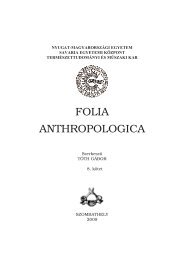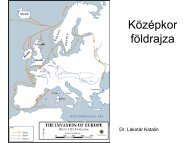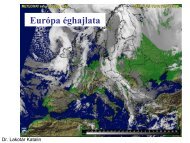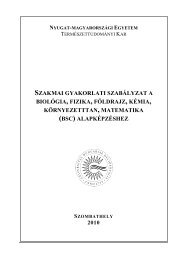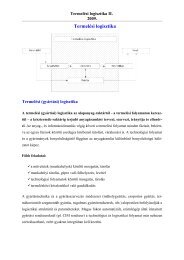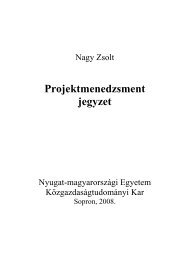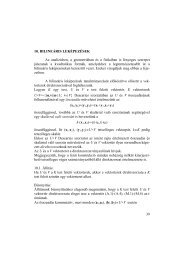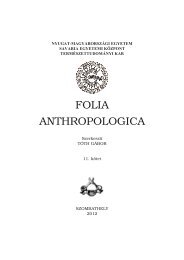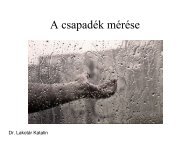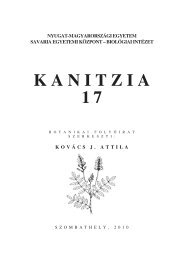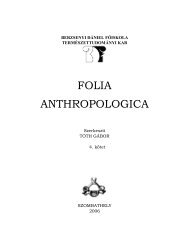Kanitzia 18. - NYME Természettudományi Kar - Nyugat ...
Kanitzia 18. - NYME Természettudományi Kar - Nyugat ...
Kanitzia 18. - NYME Természettudományi Kar - Nyugat ...
You also want an ePaper? Increase the reach of your titles
YUMPU automatically turns print PDFs into web optimized ePapers that Google loves.
The topic of the EMAPi was focused on the theoretical knowledge regarding the<br />
more invasive plants as well as making the protection against them more direct: “Bridging<br />
the gap between scientific knowledge and management practice”. The scientific organizing<br />
board was constituted of the following persons: Zoltán Botta-Dukát, Lajos Balogh, Dénes<br />
Bartha and Attila J. Kovács (Hungary), John Brock (USA), Giuseppe Brundu (Italy), Lois<br />
Child (UK), Sandy Lloyd (Australia), Petr Pyšek (Czech Republic), David M. Richardson<br />
(South Africa) and Barbara Tokarska-Guzik (Poland). The four-day conference has attracted<br />
attendants from every continent. The 136 researchers, representing 34 countries delivered<br />
34 lectures on 11 sessions and 88 posters were presented. There were invited lectures for<br />
each conference day: David M. Richardson (Stellenbosch University): (Plant) invasion science<br />
– the roads travelled and the roads ahead; Anibal Pauchard (University of Concepcion,<br />
Chile): Studying mountain plant invasions using a multi-scale approach: From ecology to<br />
management; and Philip Hulme (Lincoln University, New Zealand): Botanic gardens and<br />
the spread of environmental weeds: causes, consequences and codes of conduct.<br />
Distribution by continent of the 136 participants: Europe: 24, North America 3,<br />
Australia: 2, Asia: 2, South America 2, Africa: 1. Hungary, as host, was represented by 20<br />
participants (18 presentations - from these: 5 oral and 13 posters). It should be emphasized<br />
the significant number of researchers from the following countries: South Africa 15 persons<br />
(13: 4, 9), Poland 14 (16: 2, 14), Czech Republic 9 (8: 3, 5), Australia 6 (7: 5, 2) and New<br />
Zealand 6 (6: 5, 1). The topics and chairmen of the individual sessions: 1: Biology of invasive<br />
alien plants (Zoltán Botta-Dukát); 2: Genetics and evolution of invasive plants<br />
(Philip Hulme); 3: Risk assessment, prioritization and policy making (Llewellyn Foxcroft,<br />
South Africa); 4: Plant invasion in protected areas (David Richardson); 5: Impact of invasive<br />
plant species (Uwe Starfinger, Germany); 6: Interaction with other trophic levels: enemies<br />
and mutualists (Ingolf Kühn, Germany); 7: Management & communication (István<br />
Bagi, Hungary); 8: Introduction pathways and spread of invasive species (Petr Pyšek); 9:<br />
Plant invasion in a changing world (György Kröel-Dulay, Hungary); 10: Invasion patterns<br />
and invasibility (Franz Essl, Austria); 11: Mapping, inventories, databases (Barbara<br />
Tokarska-Guzik). On the closing ceremony, Ingolf Kühn editor-in-chief of Neobiota advertised<br />
the materials presented in the conference can be published in a thematic issue of<br />
Neobiota. John Hay, representing the net host, related that the venue of the 12 th EMAPi in<br />
2013 will be in Brasil.<br />
The conference excursions provided an insight into the most characteristic examples<br />
of the plant invasions. While the pre-conference tour led by Enikő Gaskó (Altagra)<br />
(Budapest, Vácrátót, Gödöllő, Domonyvölgy, Veszprém, Herend) and the post-conference<br />
tour, organized by Zoltán Botta-Dukát (Sümeg, Hévíz, Hegyestű, leader: István Szabó;<br />
Csákvár, Belsőbáránd, leader: Eszter Illyés; Nagykőrös, Fülöpháza, Fülöpszállás, Akasztó,<br />
Tiszaalpár, leader: Zsolt Molnár and Marianna Bíró) has led the participants inside Hungary,<br />
the mid-conference study trip organized by Lajos Balogh, encompassed six Vas<br />
County venues. Demonstration locations in the case studies for invasive plants characteristic<br />
to Western Hungary (presenting experts in parantheses): Vép, Kozár-Borzó Creek:<br />
Heracleum mantegazzianum (Attila Kovács J., Petr Pyšek); Gérce, Farkas-erdő: Phytolacca<br />
244




